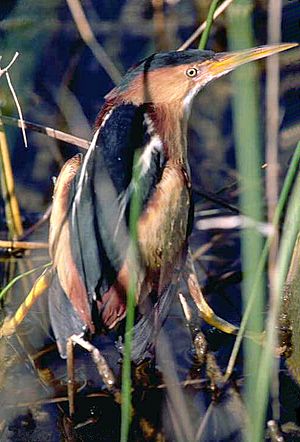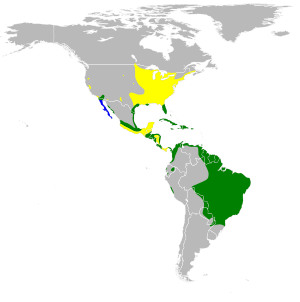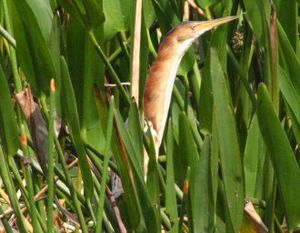Least bittern facts for kids
Quick facts for kids Least bittern |
|
|---|---|
 |
|
| Conservation status | |
| Scientific classification | |
| Genus: |
Ixobrychus
|
| Species: |
exilis
|
| Subspecies | |
|
|
 |
|
| Range of I. exilis Breeding range Year-round range Wintering range | |
| Synonyms | |
|
Ardetta exilis |
|
The least bittern (Ixobrychus exilis) is a small heron. It is the smallest type of heron found in the Americas.
Contents
What Does It Look Like?
The least bittern is one of the smallest herons in the world. It can be about 28 to 36 cm (11 to 14 in) long. Its wings can spread from 41 to 46 cm (16 to 18 in) wide. This bird is very light, usually weighing between 73 and 95 g (2.6 and 3.4 oz).
Its belly and throat are white with light brown stripes. Its face and neck sides are light brown. It has yellow eyes and a yellow beak. Adult male least bitterns have a shiny greenish-black back and head. Females have a shiny brown back and head. When they fly, you can see light brown parts on their wings.
How Does It Behave?
The least bittern is a shy bird that is hard to spot. It spends a lot of time holding onto tall reeds. If it feels scared, it will freeze in place with its beak pointing up. It turns its body and eyes towards whatever scared it. Sometimes, it even sways to look like plants moving in the wind. This helps it hide from animals that might try to eat it.
Because it can perch on reeds, the least bittern can find food in water that is too deep for other herons. It often lives in the same wetlands as the much larger American bittern. However, they usually don't bother each other. This is because they eat different things and nest at different times.
The famous bird artist John James Audubon once saw a young least bittern. He noted that it could walk easily between two books that were only 4 cm (1.6 in) apart. This shows how incredibly thin it can make its body!
Reproduction and Life Cycle
These birds build their nests in large marshes where there are many plants. They live from southern Canada all the way to northern Argentina. Their nest is a hidden platform made from cattails and other marsh plants.
The female usually lays four or five pale blue or green eggs. Both parents feed the young by bringing them food. Often, they will have a second group of babies in the same year.
Least bitterns that live in the northern parts of their range fly south for the winter. They travel at night to warmer places like the southern coasts of the United States and areas further south.
They mostly eat fish, frogs, crabs, and insects. They catch their food by quickly jabbing with their beak while climbing through marsh plants.
The number of least bitterns has gone down in some places. This is because their habitat (the place where they live) is being lost. They are still quite common, but you are more likely to hear them than see them. They prefer to walk away and hide rather than fly when disturbed. These birds make soft cooing and clucking sounds, usually in the early morning or near sunset.
Where Does It Live?
The least bittern was first described in 1789. It is closely related to the little bittern and yellow bittern.
There are five main types, or subspecies, of the least bittern:
- I. e. exilis: Found in North and Central America and the Caribbean.
- I. e. pullus: Lives in northwest Mexico.
- I. e. erythromelas: Found in eastern Panama and along the eastern coasts of South America down to Paraguay.
- I. e. bogotensis: Lives in Colombia.
- I. e. peruvianus: Found in Peru.
Conservation Status
The least bittern lives in a very large area and has a large total population. Because of this, the International Union for Conservation of Nature says its conservation status is "Least Concern". This means it is not currently at high risk of disappearing. The least bittern is also protected by the Migratory Bird Treaty Act of 1918 in the United States.
Images for kids
See also
 In Spanish: Avetorillo panamericano para niños
In Spanish: Avetorillo panamericano para niños





